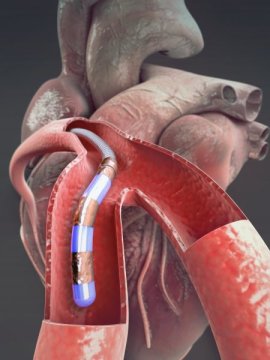[ad_1]
DGIST research team succeeded in developing a microrobot that can reach the accurate location of cardiovascular disease such as the Chronic Total Occlusion by moving and steering the microrobot towards a desired direction inside complicated blood vessels. This research is expected to increase the success rate of treatment and shorten the time of cardiovascular disease surgery.
DGIST announced on February 27 that Professor Hongsoo Choi’s team in the Robotics Engineering Department developed the ‘Magnetically Controlled Microrobot’ that can enhance the success rate of CTO treatment among myocardial infarctions through a joint research with Professor Byung-Ju Yi’s team at Hanyang University and Professor Bradley J Nelson’s team at idgenössische Technische Hochschule Zürich in Switzerland.
Since the guidewire used for percutaneous coronary intervention , which opens up the obstructed blood vessels, is controlled manually by a surgeon to change its direction and location, the success rate and speed of surgery had depended on the surgeon’s skill. It had been difficult to control the exact location and direction as the surgeon had to manually set and push the guidewire with bent ends inside complex blood vessels or junction.
To overcome this limitation, Professor Choi’s team applied flexible and biocompatible polymer as well as neodymium magnet that can control the direction and location with as external magnetic field. Using this, the team developed a cylindrical microrobot with a diameter of 500? and length of 4mm and attached it at the end of guidewire. The team developed an attachable guidewire soft microrobot that can steer the guidewire towards a desired direction by controlling the microrobot with the external magnetic field and enable a rectilinear motion through Master-Slave System .
The research team also succeeded in an experiment which mathematically calculates and predicts the microrobot’s motion and penetrates complex blood vessels through the feedforward method to control the result, in order to realize flexible, nonlinear motions of microrobot. The team also succeeded in an experiment to reach a desired area in a 3D blood vessel model that imitates the coronary artery of heart and the biocompatibility of microrobot from a cell survival experiment.
The attachable guidewire microrobot developed by the research team enables rectilinear motions through precise control by magnetic field and Master-Slave system. This can reach a desired area inside the complex blood vessel much faster, which will help overcome the percutaneous coronary intervention of existing surgical method and increase the success rate and efficiency of surgery. It will also reduce the exposure of patient and surgeon to radiation from xray as well as blood vessel damage of patients because it can reach the disease part more quickly than the existing method.
Professor Hongsoo Choi in the Department of Robotics Engineering said “Compared to the existing method, using an attachable guidewire microrobot will shorten the time for heart disease surgery and increase the success rate by enabling the surgeon to find the cause of disease more accurately and faster for a stable surgery. Our research team will work harder to conduct follow-up research with related companies and develop products that can be used in medical sites.”
Story Source:
Materials provided by DGIST (Daegu Gyeongbuk Institute of Science and Technology). Note: Content may be edited for style and length.
[ad_2]















